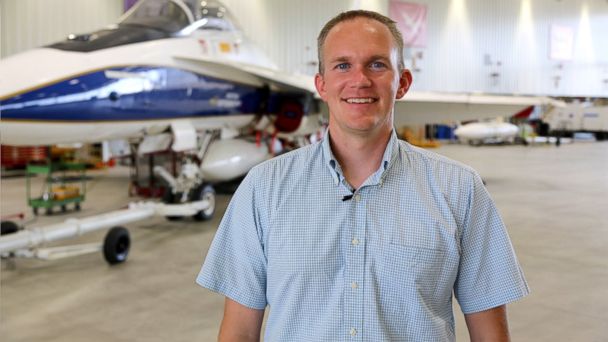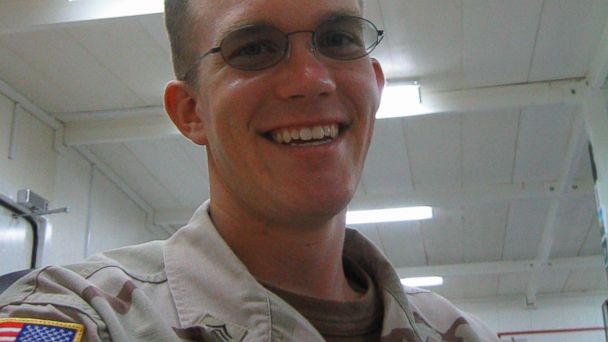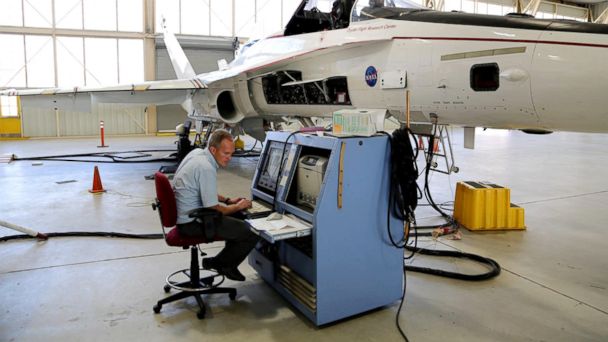Army Vet Turned NASA Engineer Helps Keep Planes in the Sky
EDWARDS, Calif. - Next time you're up in the sky sipping your drink, you might raise a toast to the people who toil to make flying safer.
Meriden, Kansas, native Daniel Goodrick is one of them.
His route to becoming an engineer for NASA took a detour after high school. H e took some time off to serve a mission in Mexico for his church but when he came back home, he joined the Utah Army National Guard as a Counterintelligence Agent in 2000 to help pay for his college tuition.

Army veteran and Electronic Instrumentation Systems Engineer, Daniel Goodrick, at the NASA Armstrong Flight Research Center at Edwards Air Force Base in California. Angel Canales / ABC News
He was deployed to Iraq in 2003 and stationed in Baghdad for a few months before he was moved to Qatar at Area Support Group camp As Sayliyah. "It was a great job and I enjoyed my deployment experience," he says.
He served seven years in the Army, ending in 2007. Goodrick went on to follow his dream and received a Mechanical Engineering degree from the University of Utah.

U.S. Army vet Daniel Goodrick (2nd from right) in a flight out of Baghdad, August 2003. Daniel Goodrick
Now he's working at the NASA Armstrong Flight Research Centerat Edwards Air Force Base in California.
Goodrick's job is making flying safer for pilots and passengers. "I make sure that planes fly the way they're supposed to," he says.As an instrumentation engineer, Goodrick designs systems to collect, transmit and store data for researchers. To put their research to test, NASA Armstrong Flight Research center created the Full Scale Advanced Systems test bed from a modified F/A-18A fighter. It tests systems under stress caused by control surface failures, weather, turbulence or pilot error. "We can basically make this test bed fly like anything we can aerodynamically model, be it a brick, a Boeing 747, a rocket, or a broken F-18," he adds.

Daniel Goodrick's office in the Defense Reporting Element of the Iraq Survey Group, Qatar. Daniel Goodrick
This technology has been used for a variety of tests since coming on-line in 2011 such as developing new control laws to handle adverse flying scenarios, to proving a peak-seeking algorithm that allows trimmed or asymmetrically loaded aircraft to fly with better fuel economy, to testing the control laws for NASA's Space Launch System rocket, the first exploration-class space vehicle in 40 years.

U.S. Army vet writing letters at Camp As Sayliyah, Doha, Qatar, 2004. Daniel Goodrick
Goodrick's project team has developed algorithms for a fly-by-wire vehicle to be flown safely with any number of control surfaces disabled or stuck, as well as algorithms that will correct pilot errors, or prevent further damage to a weakened surface by distributing control authority to other systems.

Dan Goodrick conducting a pre-flight inspection of control and instrumentation systems on the Full-scale Advanced Systems Testbed. Angel Canales/ABC News
His current project is designed to simulate a plane with a weakened control surface that can't take much stress. "For example, a roll maneuver can produce a significant load on the ailerons but if one of our ailerons is damaged, we can still complete the maneuver without further damaging it by compensating for the lack of control on the aileron by using the other control surfaces like the flaps and the rudders to prove roll control authority," says Goodrick.

Service veterans working on the Full-scale Advanced Systems Testbed team. From left: Otis Allen, DJ Catlin, Scott Erickson, Dan Goodrick, Don Warren.
This project, he says, can improve the safety for all classes of airplanes. "Airplanes are already very safe and flying on an airplane across the country is the way to go but there are unplanned events that can happen for which this technology can reduce the probability of an accident or mitigate any further issues if an incident were to occur," he says.
A good example where this technology will be useful is when a fighter pilot is in a combat zone and gets hit by something and loses partial control of the plane. "If the pilot needs to get out of the area, he may have to maneuver aggressively to escape, but without breaking the aircraft. This software will allow the pilot to continue flying without overloading the damaged surfaces that could result in a crash."
While Goodrick enjoys being part of improving flight safety, he also enjoys working for NASA. "I love working at NASA the team I work with. It is a great group of people that are devoted to research and aeronautics and we're all excited to come to work and solve problems. It is a very fulfilling opportunity to feel like we are doing something for the greater good," he says.
He credits the military for his accomplishments. "Most of the accomplishments have been as a result of serving in the military. Almost everything in my life I can trace to having served in the Army," he says. "This is very exciting for me as an engineer and researcher to feel like I'm improving things for the next generation of pilots and air passengers. There's no doubt in my mind that when this comes into production it will save lives and that is a great feeling that I get to take with me. It is a real blessing to end up here at NASA," he says.
Second Tour is an ABC News digital series profiling the lives of military veterans who are doing unique things in the civilian world.
For more stories, click here. ABC News video editor Arthur Niemynski contributed to this report.